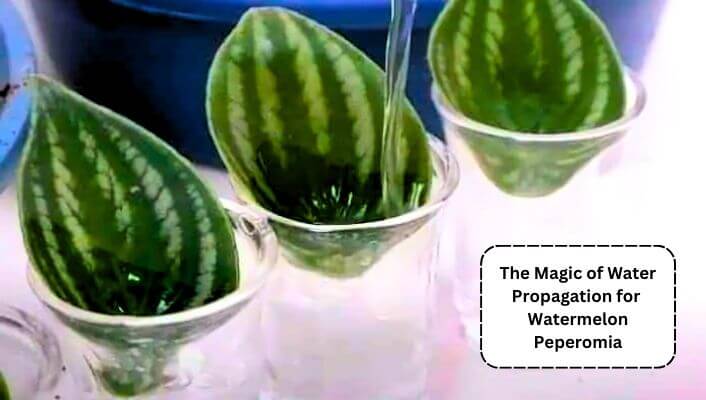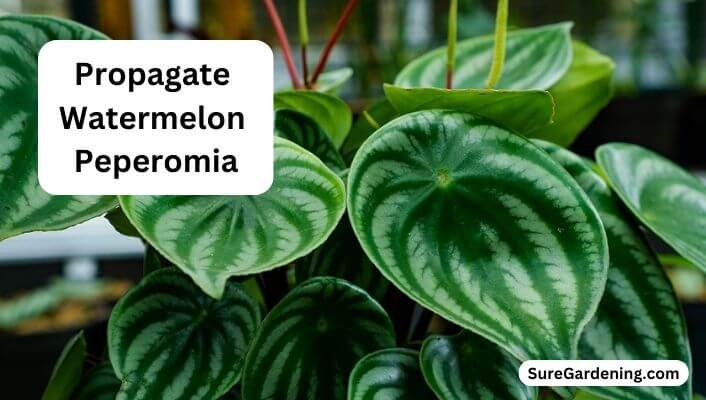Ready to get started on a fun green adventure? In our step-by-step guide, we’ll show you the magic of how to Propagate Watermelon Peperomia. With those striking watermelon-like leaves, this indoor plant is a charmer.
Whether you’re a seasoned gardener or just starting, our easy instructions will help you create a thriving indoor garden. This will leave your friends green with envy.
Let’s get your Watermelon Peperomia multiplying and flourishing with your gardening gloves!
Post Contents
- Understanding the Types of Propagation
- The Magic of Water Propagation
- Essential Tips for Successful Propagation
- Troubleshooting Common Issues
- Caring for Your New Watermelon Peperomia
- FAQs about Watermelon Peperomia
- 1. Is Watermelon Peperomia suitable for beginners?
- 2. Can I propagate Watermelon Peperomia from a single leaf?
- 3. How often should I water my newly propagated Watermelon Peperomia?
- 4. What should I do if my Watermelon Peperomia cuttings are not growing roots?
- 5. Can I keep my Watermelon Peperomia outdoors?
- 6. How often should I fertilize my Watermelon Peperomia?
- Conclusion
- Author
Understanding the Types of Propagation
Before we dive into the propagation process, let’s explore the two primary methods: leaf cuttings and stem cuttings. Each method has its own unique characteristics and advantages. Choosing the right one for you depends on your preferences and the resources you have available.
1. Propagating Watermelon Peperomia through Leaf Cuttings
Leaf cuttings are an excellent option for propagating Watermelon Peperomia. To start, select a healthy leaf from the mother plant, ensuring it’s free from any damage or disease. With a gentle hand, remove the leaf and let it air dry for a day or two.
Once it’s sufficiently dry, you can proceed to the next steps.
- Cut the leaf into sections, each containing a vein. These sections will be your leaf cuttings.
- Place the leaf cuttings in a well-draining potting mix and water lightly.
- Cover the pot with a plastic bag or a plastic dome to create a humid environment.
- After a few weeks, you’ll notice new growth from the leaf cuttings.
2. Watermelon Peperomia Propagation via Stem Cuttings
Stem cuttings provide another viable method for propagating Watermelon Peperomia. This technique is particularly effective when your plant has grown too tall or leggy, and you’d like to give it a fresh start.
- Choose a healthy stem section that has a few leaves.
- Cut the stem just below a leaf node.
- Place the stem cutting in a pot with fresh potting mix and water it gently.
- Cover the pot with a plastic bag or plastic wrap to create a mini-greenhouse effect.
- New roots should emerge in a few weeks.
The Magic of Water Propagation

Water propagation is a third method that can be used for Watermelon Peperomia. This method is a favorite for many gardeners because it allows you to observe the root development.
- Take a healthy leaf or stem cutting and place it in a clear container with water.
- Change the water regularly, ensuring it stays clean and clear.
- In a few weeks, you should notice roots forming.
- Once the roots are a couple of inches long, you can transplant the cutting into soil.
Essential Tips for Successful Propagation
Now that you’re familiar with the different propagation methods, here are some key tips to ensure your Watermelon Peperomia propagation is successful:
- Use a Well-Draining Soil Mix: When transitioning your cuttings to soil, ensure the potting mix drains well to prevent overwatering.
- Maintain Humidity: Throughout the propagation process, it’s crucial to maintain a humid environment to encourage root growth. Using a plastic bag or a humidity dome is highly recommended.
- Indirect Light: Place your cuttings in indirect sunlight to prevent them from getting burned by intense sunlight.
- Avoid Overwatering: Overwatering can lead to rot. Allow the soil to dry out slightly between watering.
- Patience: Propagation takes time. Be patient, and your Watermelon Peperomia cuttings will reward your efforts with new growth.
Troubleshooting Common Issues
Propagation isn’t always without its challenges. Here are some common issues you might encounter and how to address them:
- Rotting Cuttings: If your cuttings are rotting, it’s likely due to excessive moisture. Adjust your watering routine and ensure the cuttings have proper drainage.
- No Root Growth: If you see no roots after several weeks, try changing the propagation method or checking the cutting for signs of rot or damage.
- Wilting Leaves: Wilting leaves could be a sign of too much or too little water. Adjust your watering accordingly.
Caring for Your New Watermelon Peperomia
As your new Watermelon Peperomia plants mature, they will require the same care as the mother plant. This includes:
- Bright, Indirect Light: Place your Watermelon Peperomia in a spot with bright, indirect sunlight.
- Watering: Allow the soil to partially dry out between watering to prevent overwatering.
- Humidity: Maintain a humid environment, especially during dry seasons.
- Fertilizing: Feed your plant with a balanced, diluted liquid fertilizer during the growing season.
FAQs about Watermelon Peperomia
1. Is Watermelon Peperomia suitable for beginners?
Yes, Watermelon Peperomia is an excellent choice for beginners due to its low-maintenance nature.
2. Can I propagate Watermelon Peperomia from a single leaf?
Yes, you can propagate Watermelon Peperomia from a single leaf using leaf cuttings.
3. How often should I water my newly propagated Watermelon Peperomia?
Water your new cuttings when the top inch of soil becomes dry. This will vary depending on your home’s humidity and temperature.
4. What should I do if my Watermelon Peperomia cuttings are not growing roots?
If you’re not seeing root growth after a few weeks, try changing the propagation method or examine the cuttings for any signs of rot or damage.
5. Can I keep my Watermelon Peperomia outdoors?
Watermelon Peperomia is best suited for indoor conditions with bright, indirect light. It’s not cold-hardy and should be protected from extreme temperatures.
6. How often should I fertilize my Watermelon Peperomia?
Fertilize your Watermelon Peperomia with a balanced, diluted liquid fertilizer during the growing season, about once a month.
Conclusion
Propagating Watermelon Peperomia is a rewarding journey for any plant lover. With a bit of patience and care, you can enjoy not just one, but multiple stunning Watermelon Peperomia plants in your home.
Remember to choose the propagation method that suits you best and maintain the right conditions for successful growth. Happy gardening!

